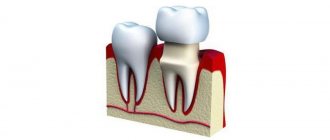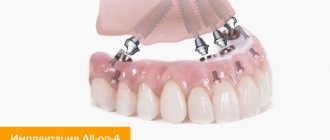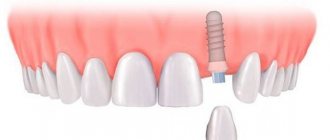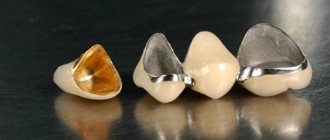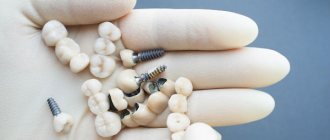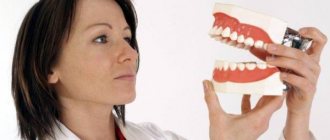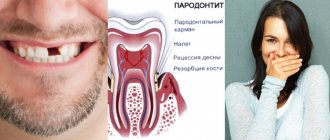Characteristic signs
Occlusions themselves are not considered a life-threatening condition. Most people can lead a normal life and complain only about the aesthetic unattractiveness of their smile.
But ignoring the problem can lead to serious consequences. You need to pay attention to the characteristic symptoms of a pathological bite:
- pain, clicking while chewing;
- deformation of tooth enamel (chips, microcracks);
- headaches, temporal pain;
- constant involuntary biting of the tongue, lips, inner surface of the cheeks;
- problems with diction;
- change in facial appearance.
If home diagnostics indicate that a deep bite has developed, it is recommended that you make an appointment with an orthodontist.
Deep bite often develops in childhood
Prevention
To avoid long-term treatment of deep bite, you should adhere to certain rules and follow recommendations for the prevention of pathology. Prevention includes:
- control of the baby's position during feeding;
- weaning children from bad habits;
- treatment of caries;
- timely elimination of pathologies of the skeletal system;
- refusal to artificially feed the child;
- inclusion of solid foods in the diet - carrots, apples;
- regular dental examination.
It is impossible to get rid of the deficiency on your own, therefore, when the first signs of a deep bite appear, you must seek help from an orthodontist.
Causes
There are several reasons that lead to the development of a deep bite. The pathology develops in early childhood, but can also be acquired and manifest in adulthood. The main causes of deep bite in children and adults:
- congenital narrowing of the upper jaw;
- crowded arrangement of the upper teeth;
- constant thumb sucking, pacifiers in infancy;
- bruxism;
- habit of biting nails or random objects (pencils, candies, nuts);
- dysfunction of the temporomandibular joint.
Sometimes the cause of acquired malocclusion is the absence of a lower tooth. It is necessary to undergo an implantation or prosthetics procedure before destructive processes begin.
Deep bite often provokes biting of soft tissues
Classification
There are several degrees of pathology; the classification is based on the degree of overlap of the lower incisors with the upper ones.
The following degrees of defect are distinguished:
- deep (incisal) overlap - a defect in which the edge of the lower tooth reaches the palatal tubercle of the upper one;
- reducing bite - it is characterized by the fact that the incisors of the lower jaw do not rest on the dental cusps of the upper teeth, they slide to the edge of the opposite gum;
- traumatic disocclusion - in which the edges of the lower incisors rest against the upper palate or gum.
This process means a gradual deterioration of the condition. If nothing is done, the pathology steadily progresses and moves to the next stage.
Why is a deep bite dangerous?
It must be remembered that violations of central occlusion are not a cosmetic problem. Pathological displacement of the jaw leads to various complications.
The part of the lower incisors that is constantly in contact with the upper teeth wears out much faster. Patients who suffer from bruxism eventually notice the appearance of chips and cracks in the enamel.
If jaw displacement leads to frequent biting of soft tissues, then eventually bleeding ulcers appear on the inner surface of the cheeks. Such growths can make eating painful and uncomfortable.
People with a deep bite also often suffer from pain in the temples and temporomandibular joint. One of the most serious complications: the development of breathing disorders during sleep.
Inflammation of the gums may develop against the background of a deep bite
Description of the pathology
Deep bite is one of the most common defects in teeth closure. It is also called vertical malocclusion. With this pathology, the mandibular incisors overlap the upper ones by one third or more. In some cases, such an anomaly is observed in the area of the lateral parts of the jaw. The problem can occur in adults and children.
A defect in the form of deep occlusion is accompanied by loose teeth, inflamed gums, oral injuries, swallowing problems and impaired breathing. Aesthetic signs are manifested in shortening the lower part of the face, thickening the lower lip and deepening the crease of the chin. The patient may experience headaches. In addition, while chewing food, a crunching sound is sometimes heard, which indicates the occurrence of dysfunction and arthrosis of the TMJ. It is painful for the patient to bite and chew food.
The pathology is also characterized by speech impediment and extreme stress on the front teeth, which quickly wear out. This leads to dysfunction of the masticatory muscles. If the problem is neglected, a person may develop gingivitis, periodontitis, periodontal disease or stomatitis.
Deep bite in children
If the baby was born without obvious disorders of the jaw structure, it is necessary to stop using pacifiers and bottles frequently, and also ensure that the child does not suck his finger. Simple rules will help reduce the risk of developing pathologies of central occlusion.
If the dentist notices that a small patient tends to breathe through the mouth and also tends to place the tongue near the palate, then regular wearing of a trainer is prescribed. A dense silicone mouth guard will help you form the right habits.
If a child is predisposed to developing malocclusion, the doctor may prescribe trainers.
Features of distal bite
Many people mistakenly consider deep bite and distal bite to be synonymous pathologies. Despite the external similarity of the pathologies, the reasons are completely different. Prognathia is a sign of rare genetic disorders and often requires surgical intervention.
In addition to the help of an orthodontist, the patient will also need advice from other specialists.
The main causes of the pathology:
- gigantism: abnormally accelerated skeletal growth in childhood, provoked by hormonal imbalance;
- acromegaly: a sharp increase in skull growth in adulthood. The pathology is associated with disturbances in the functioning of the pituitary gland;
- nevoid basal cell carcinoma syndrome: a series of inherited genetic defects that affect bone development;
- Crouzon syndrome: premature fusion of the skull bones, which develops due to genetic mutations.
To cure prognathia, you will need the help of multidisciplinary medical specialists.
Distal bite
Diagnostics
To establish a diagnosis of deep occlusion, its degree and type, the following examination methods are used:
- visual examination of the oral cavity;
- taking diagnostic impressions;
- studying photographs of the patient’s face in profile and frontal view;
- orthopantomography – overview x-ray;
- teleradiography – ferry radiography of the facial skeleton in lateral and frontal projection;
- electromyography – analysis of the bioelectrical activity of muscles and nerve function.
A thorough diagnosis helps develop a plan to correct your bite.
Important! Additionally, computed tomography is used with 3D modeling of the patient’s facial skeleton in the current state and after bite correction.
Correction of deep bite
The modern orthodontic department offers many different methods of treating pathology. The type of therapy will depend on how severe the problem is and what triggered it. The patient does not need to understand all types of orthodontic structures. The dentist will briefly explain the advantages and disadvantages of each technique.
Trainers for teeth
Thickened silicone mouthguards are most often recommended for teenagers and young children. The product, made of dense silicone, is inexpensive and allows you not only to straighten your teeth, but also to correct the position of your tongue.
Plates (palatal retainers)
Orthodontic plates are also more suitable for teenagers and primary school children. Palatal retainers do not put as much pressure on the teeth as braces, but they allow you to correct the occlusion while the jaw is not fully formed.
Teeth Straightening Plate
An orthodontic plate can straighten concave molars, prevent palate deformation, and facial asymmetry. The product consists of a plastic base, supporting arches and metal fasteners. Each retainer is made individually, based on a 3D model or cast of the jaw.
The plate itself is attached to the teeth using special hooks. A small patient will have to wear a palatal structure for at least 14-16 hours a day.
If the structure is equipped with a special orthodontic screw, then it should be tightened with a special key as often as the orthodontist advises. Average duration of therapy: 13-15 months.
Aligners (aligners)
Those who want to correct a deep bite without the use of bulky metal structures are recommended to consider installing transparent aligners. Once every two weeks you will have to visit the orthodontist’s office to make a new impression, on the basis of which a new aligner will be made. Elements of the dentition will shift gradually, without causing intense pain.
Mouthguards will have to be worn almost 24/7
To achieve visible results, you will have to wear the aligners 22 hours a day (even at night). But you need to keep in mind that silicone inserts will not work if the jaw has been injured or the distance between the upper and lower incisors exceeds 7 mm.
Herbst apparatus
A design similar to metal braces is prescribed to patients who have pathological curvature of molars. The upper and lower chewing teeth are connected by a dense metal tube.
Treatment methods in adults
In adults , following general recommendations and wearing removable appliances is not advisable , since the dental system is already formed and is much less amenable to correction.
The main methods of treatment are:
- installation of a bracket system. The choice of its type depends on the complexity of the pathology, preferences and financial condition of the patient;
- The Herbst apparatus is installed after six months of wearing braces in order to correct the position of the lower jaw (if necessary).
The design forces the jaw to be in an extended position all the time. Thanks to this, the work of the muscles responsible for the position and functioning of the lower jaw is restructured, changes occur in the TMJ and the position is fixed; - prosthetics or implantation, in difficult cases;
- surgical correction of the bite, for example, increasing the length of the lower jaw, if there is severe facial asymmetry;
- manual massage is only possible as an auxiliary treatment for deep bite. The massage therapist uses his hands to influence certain points, and thanks to this, the correction of the facial bones is faster and less painful;
- Mouthguards or aligners are used to straighten teeth in cases of mild pathology; more details about this method are written here.
Duration
The duration of treatment is long - from one and a half years . At this time, the patient periodically visits his doctor to replace the arches with more rigid ones, which increase pressure on the teeth and allow them to correct the position.
In some cases, wearing braces can last much longer - 3-4 years . This depends on the complexity of the pathology and some individual features of the structure of bone tissue.
Retention period
After removing the bracket system, a retention period begins, during which it is necessary to preserve and consolidate the result obtained. For this, various orthodontic devices can be used, both removable and non-removable - mouthguards, plates, etc.
The duration of this period is on average equal to the time of wearing braces, but in some situations adults are advised to wear retention devices for life.
How long does the treatment last?
The exact duration of orthodontic therapy is determined individually for each patient. The period depends on the degree of occlusion violation and other related factors. The positive effect is most noticeable in children and adolescents.
The older a person is, the stiffer and more stable his periodontal ligaments are, which means that the correction procedure can take several years. It should also be taken into account that without wearing special retainers, the teeth may return to their original position.
You should not refuse orthodontic treatment for fear of high cost and duration. Modern dental technologies make it possible to produce invisible and comfortable corrective structures. It is worth reading the reviews, studying videos of therapy results and, finally, taking the first step towards achieving a beautiful smile.
